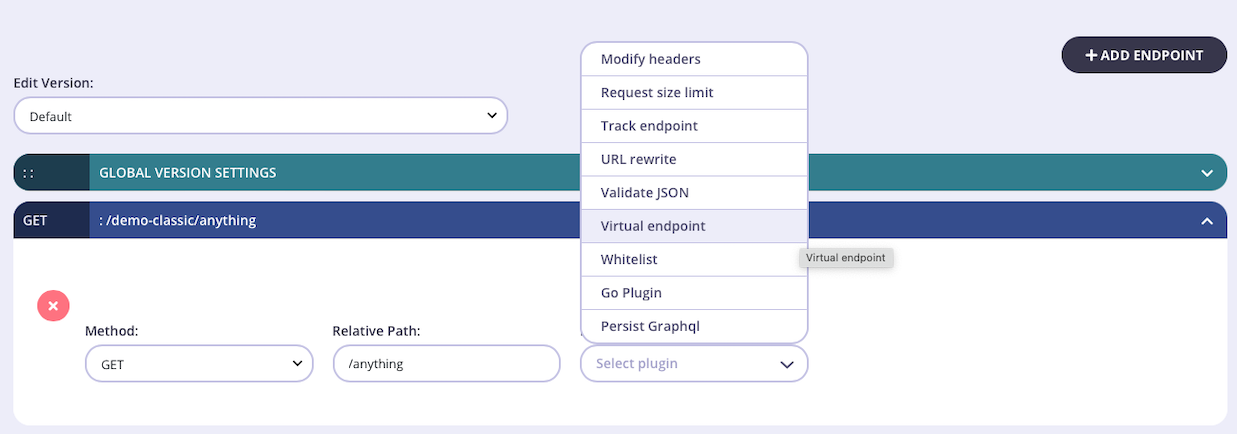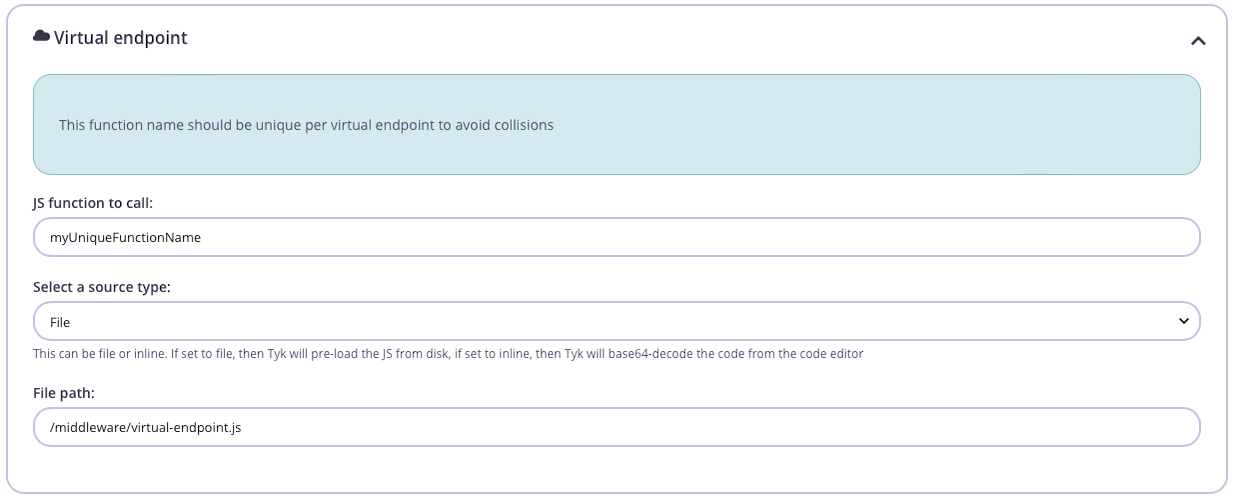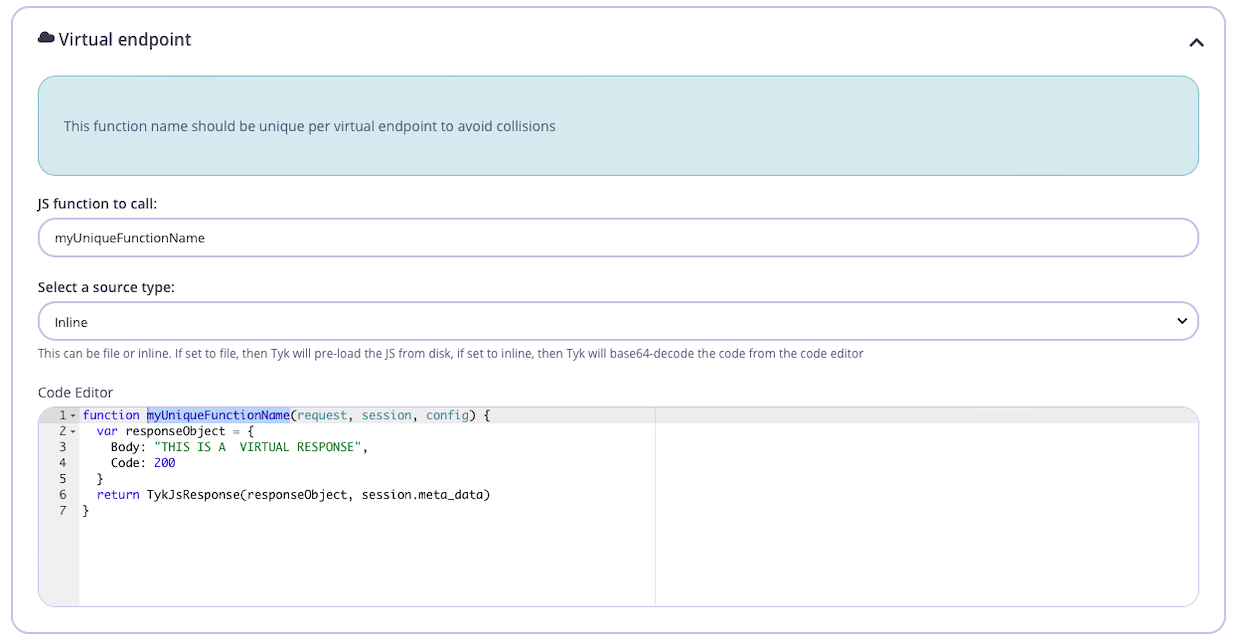Using the Virtual Endpoint middleware with Tyk Classic APIs
Last updated: 4 minutes read.
The virtual endpoint middleware provides a serverless compute function that allows for the execution of custom logic directly within the gateway itself, without the need to proxy the request to an upstream service. This functionality is particularly useful for a variety of use cases, including request transformation, aggregation of responses from multiple services, or implementing custom authentication mechanisms.
This middleware is configured in the Tyk Classic API Definition. You can do this via the Tyk Dashboard API or in the API Designer.
If you’re using the newer Tyk OAS APIs, then check out the Tyk OAS page.
Configuring the middleware in the Tyk Classic API Definition
If you want to use Virtual Endpoints, you must enable Tyk’s JavaScript Virtual Machine by setting enable_jsvm to true in your tyk.conf file.
To enable the middleware you must add a new virtual object to the extended_paths section of your API definition.
The virtual object has the following configuration:
path: the endpoint pathmethod: the endpoint HTTP methodresponse_function_name: this is the name of the JavaScript function that will be executed when the virtual endpoint is triggeredfunction_source_type: instructs the middleware to look for the JavaScript code either in afileor in a base64 encodedblob; the actual file location (or base64 encoded code) is provided infunction_source_urifunction_source_uri: iffunction_source_typeis set tofile, this will be the relative path to the source file containing the JavaScript code; iffunction_source_typeif set toblob, this will be abase64encoded string containing the JavaScript codeuse_session: a boolean that indicates whether the virtual endpoint should have access to the session object; iftruethen the key session data will be provided to the function as thesessionvariableproxy_on_error: a boolean that determines the behaviour of the gateway if an error occurs during the execution of the virtual endpoint’s function; if set totruethe request will be proxied to upstream if the function errors, if set tofalsethe request will not be proxied and Tyk will return an error response
For example:
|
|
In this example the Virtual Endpoint middleware has been configured for requests to the GET /anything endpoint. For any call made to this endpoint, Tyk will invoke the function myUniqueFunctionName that is base64 encoded in the function_source_uri field. This virtual endpoint does not require access to the session data and will not proxy the request on to the upstream if there is an error when processing the myUniqueFunctionName function.
Decoding the value in function_source_uri we can see that the JavaScript code is:
|
|
This function will terminate the request without proxying it to the upstream returning HTTP 200 as follows:

HTTP/1.1 200 OK
Date: Wed, 28 Feb 2024 20:52:30 GMT
Server: tyk
Content-Type: text/plain; charset=utf-8
Content-Length: 26
THIS IS A VIRTUAL RESPONSE
If, however, we introduce an error to the JavaScript, such that Tyk fails to process the function, we will receive an HTTP 500 Internal Server Error as follows:

HTTP/1.1 500 Internal Server Error
Date: Wed, 28 Feb 2024 20:55:27 GMT
Server: tyk
Content-Type: application/json
Content-Length: 99
{
"error": "Error during virtual endpoint execution. Contact Administrator for more details."
}
If we set proxy_on_error to true and keep the error in the Javascript, the request will be forwarded to the upstream and Tyk will return the response received from that service.
Configuring the middleware in the API Designer
You can use the API Designer in the Tyk Dashboard to configure a virtual endpoint for your Tyk Classic API by following these steps.
Step 1: Add an endpoint for the path and select the plugin
From the Endpoint Designer add an endpoint that matches the path for which you want to trigger the virtual endpoint. Select the Virtual Endpoint plugin.

Step 2: Configure the middleware
Once you have selected the virtual endpoint middleware for the endpoint, you need to supply:
- JS function to call
- Source type (
fileorinline)
If you select source type file you must provide the path to the file:

If you select inline you can enter the JavaScript code in the Code Editor window.

Step 3: Save the API
Use the save or create buttons to save the changes and activate the Virtual Endpoint middleware.
Note
The Tyk Classic API Designer does not provide options to configure use_session or proxy_on_error, but you can do this from the Raw Definition editor.